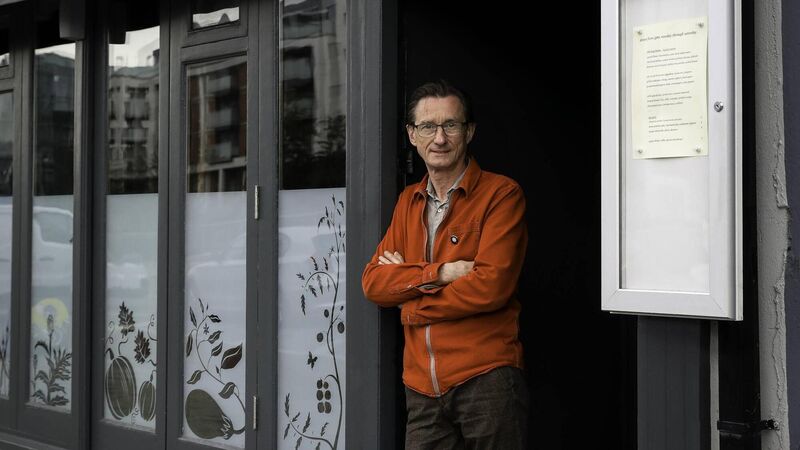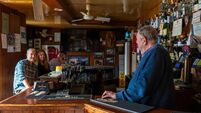The Paradiso Effect: Denis Cotter launches his fifth cookbook

Denis Cotter, owner and executive chef of Paradiso in Cork Picture: Ruth Calder-Potts
DENIS Cotter, chef-patron of pioneering vegetarian restaurant Paradiso, has released his fifth cookbook.
Paradiso: Recipes and Reflections, is his first in 12 years and will be the last he writes with the restaurant in mind.
First came The Café Paradiso Cookbook (1999), Paradiso Seasons (2003), a memoir with recipes in Wild Garlic, Gooseberries… And Me (2007), and For The Love of Food (2011).
His latest penning, however, should not be thought of as fifth in the series. Defined by the publisher as a cookbook, Denis thinks of it more as a manual and a snapshot of where the restaurant is today, at 30 years young.
As we talk about the book and his reasons for writing it, I sense maybe this is an homage to the restaurant Cotter has dedicated his professional life to; a swansong moment three decades in the making. This book has much to carry between its pages.

The book was originally conceived as a self-publishing project only to be used in-house by the Paradiso team.
“It was just going to be text, more of a manual really. I had John Foley (designer) on board, but I needed a project manager and that’s when I found Kristin [Jensen, publisher].”
Paradiso: Recipes And Reflections has become more than a manual. There is plenty of ‘how-to’ for replicating Paradiso’s culinary style and 160 recipes with which to try out those techniques, and there are a handful of short essays that play on Cotter’s observations from the restaurant.
“First and foremost, the book is a marker of where Paradiso is now, in the present and setting us up for the future,” says Cotter.
“We have four other books on the shelf; they’re not bad books but they are out of date. I wanted to take those off the shelf and put something on that represents Paradiso today.”
They say age ain’t nothing but a number, but Cotter is concerned that as the years tick by, so comes greater risk of irrelevance, something he is resolutely unwilling to allow on his watch.
“We are 30 years old, but I’m the only old person here! It’s a young and vibrant restaurant, and I want that reflected in this book,” says Cotter.
“Coming out of Covid, I saw an opportunity to change, rejuvenate and revitalise. It’s easy to be forgotten about when you’ve been around so long, the restaurant world focuses on what’s new. I wanted to completely rejuvenate everything, change the menu format, and create a book that would launch the next few years of the restaurant. Everything is in there; we have so much material to work with, and I wanted to use all of it as building blocks for a whole new catalogue of things.”
The book is dotted with mini essays, each a little vignette into the world of Paradiso through Cotter’s eyes.
“I went away to Beara for a week to get the introduction written, and when I sent Kristin back the material, it included two short essays – random things that just popped up in between the recipes. Kristin said to write more of those.
“The essays are tiny, just 300 words long; I’m very long winded in type, so I found it really hard to write a piece that’s so short and still able to say something and not be dull!”
Cotter says the essays are not personal, but it is hard to see how they aren’t with such reflections as Paradiso’s cous cous cake.
“We came across the old cous cous cake recipe originally published in Paradiso Seasons, and the new book contains the most updated version of it. A tiny little thing springs from it: Cous Cous, Jam and Men. It’s about how this dish of cous cous cake with date jam, lemony chickpeas and smoky greens became the go-to safe dish in Paradiso for men to order, and why men locked onto this as the meaty, knife and fork dish that’s safe, when it doesn’t sound safe to me at all!”

When Cotter recalls something like this, it is hard to take his assertion at face value that this book is not personal to him.
Several years have passed (and three head chefs in) since deciding to step back from the kitchen. I wonder if the desire to preserve what Paradiso is now is some way of also preserving his fingerprint on the restaurant before it evolves even further away from him.
“What I mean by this book being about where Paradiso is now is to do with the repertoire. Since I stopped being head chef, I’ve had Eneko Lopez, Meadhbh Halton and now Miguel Frutos as my head chefs. What I realised during all that process is that there is a strong repertoire. I know I started it, but in the process of working with these chefs, the repertoire has become defined.
“There are things in it from way back that we don’t do anymore, but it’s in there somewhere – the spicing or certain combinations are still there even though we might not make the dish they originally appeared in.
“Everything in the repertoire is available to us, and good material for young creative chefs to work into a modern cuisine. That’s preferable to a new head chef bringing his own style in because, what if they leave? Are we stuck doing their food? This way we’re not - we’re only ever doing Paradiso food.”
This is the stuff of legacy. Paradiso is more than the space it inhabits. It’s a cuisine in its own right.
When the restaurant first opened in 1993, Cotter’s vision was for Paradiso to stand with “normal” restaurants. Three decades on, for this echelon of restaurant, normal looks ever more like Paradiso flipping the narrative on what high end vegetarian dining can be.
“In the early days, it used to be that restaurants had one vegetarian dish on their menus, but now young chefs running their own kitchens are naturally thinking creatively about vegetables,” he says.
“That generation grew up with parents who had a modern attitude to good food. I grew up in the old world and had to learn to cook, but now there’s a maturity in this second generation who naturally cook instinctively, whereas we had to think about good food intellectually.”
Could there be such a thing as The Paradiso Effect? As a diner, I certainly see that influence carrying through in other restaurants and proffer to disagree with Cotter’s fear of Paradiso being forgotten.
“I do feel that the influence Paradiso has had on the wider industry is one thing, but this place now and what it does - I don’t want it to be the grandfather that is respected for the influence it had, I want it to be seen as an important restaurant now and in the future – not something historical.”

Paradiso belongs in the space where influence and relevance meet.
The 160 recipes selected for Paradiso: Recipes And Reflections show a love affair with flavour, texture, colour and spice. Seasonal Irish vegetables collide with North African spicing or Asian funky ferments while brushing with bright flavours of the Mediterranean.
“That’s always been there, it comes from Fusion back in the day,” explains Cotter, who fell in love with that rampaging style of cookery after a year in New Zealand. It’s a joyful way to explore food and flavour reflected in the Paradiso style and the hunt for good flavour.
“It’s all the time chasing down flavour, asking what does a dish need to take it one step further? We shouldn’t try to be an expert at all the different global cuisines, just take a bit and bring it into your own. If I say I think a dish needs ginger, let’s try it and see what happens.”
The food photography in the book by Ruth Calder-Potts riffs on that playfulness and showcases sophisticated Paradiso dishes with an exuberant display of firework-like colours and speaks to the aliveness of vegetables.
“Colour has always been there,” explains Cotter. “It’s built into our dishes now and the colours that go on the plate are a starting place.
“Originally, my own cooking was rich and the simple ways to introduce richness werethrough dairy and olive oil, and flavour had a lot to do with spice and tonnes of herbs. Quite often now it’s done in a slower way: concentration, drying, reducing, and with better machinery you can produce and preserve colour. It’s a more sophisticated way of going after the same result, but the aim is the same: to enrich and bring out as much flavour as possible.”
If there was a word to sum up succinctly what Cotter means when he says the book is a snapshot of where Paradiso is now, sophisticated is where we land, and, he says, an attempt “to represent the people who are here”.
So, this is the last Paradiso book Cotter will write, but why stop now?
“My hope is that it will be enough. This is us putting a flag up and saying: we are a modern restaurant with an eye on the future, and I expect it to give the restaurant three to five years of relevance. I’m going to be past retirement age by then, and I don’t expect to be here in the restaurant after that.”

The recipe Cotter marks out as his favourite celebrates the humble turnip.
“The Turnip Galette is a dish that’s evolved over time. It used to be the biggest main course we did with four layers of braised turnip with chestnut mushroom in between, rich beetroot and port gravy, potato mash and brussels sprouts, and we turned it into the elegant version we use today. I’m very proud of that dish because I can remember exactly how I felt when I created it in 2006.”
This is what Paradiso has always done: taking seasonal Irish vegetables and giving them the rock star treatment – Sexy Veg. It’s why a turnip is emblazoned in gold on the front of the book.
What’s next for Paradiso and Denis Cotter are two distinct and separate things. It’s Cotter’s hope that this book will reassert Paradiso’s relevance onto Ireland’s gastronomic map and provide a bedrock for the repertoire of dishes to “move further and further away from the starting point and to something perhaps relevant for an indefinite time”.
His own future ambition is much more subdued. Maureen’s is the bar he runs with his wife on Shandon Street - his happy place.
“Most of all,” he says, “I like being a barman.”







 App?
App?


